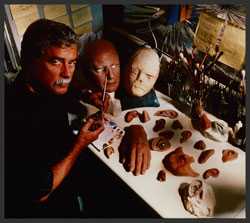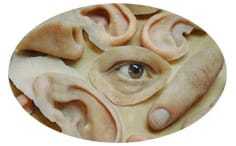About CIA’s Impact on Technology
Virtually any job you can imagine is available at the CIA. In addition to the more well-known jobs of analyst or core collector, the Agency needs medical professionals, IT specialists, graphics artists, and other skilled personnel–even sometimes hair stylists, carpenters, and seamstresses–to accomplish its mission of protecting the national security of the United States. Because of the need to work in somewhat of an independent environment, the CIA must sometimes develop technologies to meet the unique requirements of its officers. With this in mind, you might not be surprised to learn that, after a declassification process, publicly released technologies developed by CIA have gone on to impact the world in positive ways.
One of CIA’s best examples of such technology may hit closer to home than you’d think–the lithium-iodine battery. Developed in the 1960s by CIA to solve the problems of varying reliability and short lifespan of batteries, the lithium-iodine battery improved the performance of surveillance equipment and prolonged the operation of reconnaissance satellites. In the modern sense, the benefits of this declassified technology can be felt all the way from professional arenas such as, the medical community’s use of it in pacemakers, to less-formal arenas like powering your cell phone or digital camera.
The medical community often benefits from research and development performed by the CIA and other Intelligence Community organizations. For example, to assist radiologists in detecting breast cancer, CIA provided technology originally developed for the analysis of satellite imagery. Specifically, the technique involved aligning and comparing digital x-ray images taken over time to identify any changes. These results were particularly helpful in diagnosing breast cancer in women under 50, where diagnosis is particularly difficult. The use of these methods is believed to have considerably reduced the number of deaths from breast cancer.
CIA developed the Identi-Kit to assist in sketching the face of a person of interest based upon witness recollections. The kit breaks a full-face image into component parts–hair, brows, eyes, nose, lips, chin-line with ears, and age lines, plus beard, hat, and glasses, if any. It contains several dozen transparent slides picturing each of these components with different types of contours, 500 slides in all, with five notches on the side for different placements of each feature. From the kit’s catalog of slides, a witness selects those that best portray the subject person’s facial characteristics. The resulting image is not a finished portrait but a reasonably good line-drawing of distinctive physical contours. A key benefit of the kit is the ease with which it permits a sketch to be sent quickly via telephone using only slide codes that enable reconstruction of the sketch with another kit. The kit also provides a standardized set of facial descriptors that may be used in identifying a wide spectrum of individuals. After intelligence officers thoroughly proved Identi-Kit’s utility in many real-life operations over recent years, CIA released it to police forces for use in apprehending criminals.

After retiring from CIA, Bob Barron leveraged his unique skillset to design custom prosthetics for patients who needed them. Here, Bob works on a prosthesis in his lab. (Photo courtesy of Robert Barron)
A non-traditional way that CIA has helped make a significant impact on the world is through one of its former employees. Robert Barron, a currently certified clinical anaplastologist, honed much of his natural artistic talents during his work as a CIA disguise specialist. Having retired from CIA in 1993, Barron now works with medically disfigured patients to improve their confidence and restore their sense of identity by designing prosthetics tailored specifically for each patient. Barron credits his time at the CIA as the foundation for his second career, stating, “my work with disguises is what led me to where I am now.” He further explained that each operational disguise piece he created at CIA was “unique and demanded creativity,” much like the prosthetics he currently designs. If you are interested in reading more about Barron, click here to access a previously featured article about him.

Twenty-four years of altering identities as a Senior Disguise Specialist with the CIA honed Robert Barron’s ability to provide incredibly realistic and functional prosthetics for his patients.
Finally, the CIA-assisted technology probably most familiar to you is one many of us use on a regular basis: Google Earth. In February 2003, the CIA-funded venture-capitalist firm In-Q-Tel made a strategic investment in Keyhole, Inc., a pioneer of interactive 3-D earth visualization and creator of the groundbreaking rich-mapping EarthViewer 3D system. CIA worked closely with other Intelligence Community organizations to tailor Keyhole’s systems to meet their needs. The finished product transformed the way intelligence officers interacted with geographic information and earth imagery. Users could now easily combine complicated sets of data and imagery into clear, realistic visual representations. Users could “fly” from space to street level seamlessly while interactively exploring layers of information including roads, schools, businesses, and demographics. In the private sector, this flyover capability was so compelling that multiple TV networks used EarthViewer 3D to fly over Iraqi cities and landscapes in news broadcasts using publicly available satellite images. All of this acclaim eventually caught the attention of Google Inc., a multinational cyber-focused corporation, which acquired Keyhole in 2004, thereby laying the groundwork for the development of Google Earth.
So the next time you are exploring a new land from the comfort of your laptop or snapping pictures with your lithium-battery-powered digital camera, take a moment to think about some other ways CIA technology may have improved life outside its walls.
Video
The CIA represents people from all walks of life.
Besides traditional intelligence officers, the Agency also needs doctors, hair stylists, seamstresses, and other skilled personnel to help meet the unique needs of its mission.
With this in mind, you might not be surprised to learn that declassified, publicly released technologies developed by CIA have impacted the world in positive ways.
One of the best examples is the common lithium-iodine battery, developed by CIA in the 1960s to improve the performance of surveillance equipment and prolong the operation of reconnaissance
satellites.
The benefits of this declassified technology can be felt close to home today, from its use in pacemakers to your cell phone and digital camera.
The medical community often benefits from research and development performed by the CIA.
For example, technology that CIA originally developed for the analysis of satellite imagery was made available to assist radiologists in detecting breast cancer.
By aligning and comparing digital x-ray images taken over time, radiologists are able to identify changes.
This technique is especially useful in detecting breast cancer in women under 50, where diagnosis is particularly difficult.
A former CIA employee, now a certified clinical anaplastologist, has had a significant impact on the lives of many medically disfigured patients.
Having honed his talents as an Agency disguise specialist, he now designs custom prosthetics for patients to help restore their sense of identity and bolster their confidence.
“My work with disguises is what led me to where I am now,” he says, crediting his time at the CIA as the foundation for his second career.
The CIA-assisted technology that may be most familiar to you began as a way for intelligence officers to combine complicated data sets and imagery into clear, realistic visual representations.
Allowing users to “fly” from space to street level seamlessly, exploring layers of information including roads, businesses, and demographics, this groundbreaking technology was acquired in 2004 and laid the groundwork for the development of Google Earth.
So the next time you are exploring a new land from the comfort of your laptop or texting a friend on your lithium-battery-powered cell phone, take a moment to think about the many ways CIA technology has improved life outside its walls.
